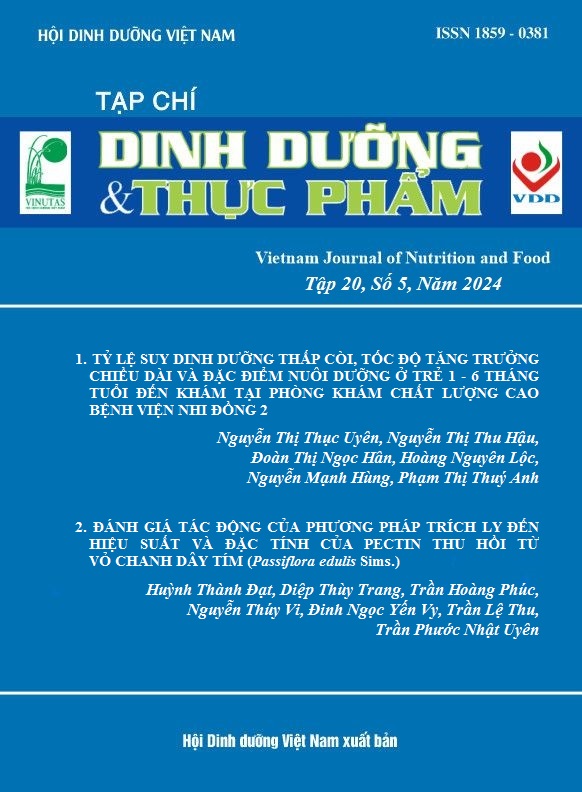ANTIBACTERIAL AND ANTIOXIDANT ACTIVITIES FROM LEAF EXTRACTS OF Cymbopogon citratus
Main Article Content
Abstract
Aims: The study aimed to determine the active ingredients, antibacterial and antioxidant properties of C. citratus leaf extract in water, 96% ethanol, and 96% methanol.
Methods: The qualitative method for the identification of natural compounds in C. citratus leaf extract based on color reactions. The antioxidant capacity of the extract was investigated using the diphenylpicrylhydrazyl (DPPH) free radical scavenging method. The antibacterial capacity was investigated using the agar-well diffusion method.
Results: Active ingredients found in C. citratus leaf extract included alkaloids, flavonoids, saponins, terpenoids, coumarin quinone, and tannins. The greatest results for C. citratus leaf extract were obtained with a 96% methanol solvent.. The antibacterial activity of the extract on E. coli was 2.50 ± 0.50 and the highest antioxidant efficiency was 95.77% with an IC50 value of 298.40 μg/mL in C. citratus leaf extract in solvent methanol 96%.
Conclusion: Extracts from 96% methanol solvent had the ability to extract most of the compounds in C. citratus leaf extract such as: alkaloids, flavonoids, saponins, terpenoids, quinones, and tannins. All 3 types of C. citratus leaf extracts in water, 96% ethanol, and 96% methanol had antibacterial properties. From the above results, it can be seen that C. citratus leaves are a potential material for studies on antibacterial, antioxidant properties and other studies on natural compounds with biological activity.
Keywords
leaf extract, antibacterial, antioxidant, 𝘊𝘺𝘮𝘣𝘰𝘱𝘰𝘨𝘰𝘯 𝘤𝘪𝘵𝘳𝘢𝘵𝘶𝘴
Article Details
References
2. Milica A, Ivana Č, Mirjana C, et al. Cymbopogon citratus (DC.) Staph: Chemical composition, antimicrobial and antioxidant activities, use in medicinal and cosmetic purpose. J Agron Technol Eng Manag. 2019;2(6):344-360.
3. Sessou P, Farougou S, and Sohounhloué D. Major component and potential applications of plant essentials oils as natural food preservatives: a short review research results. Int J Biosci. 2012; 2(8):45-57.
4. Balakrishnan B, Paramasivam S, and Arulkumar A. Evaluation of the lemongrass plant (Cymbopogon citratus) extracted in different solvents for antioxidant and antibacterial activity against human pathogens. Asian Pacific Journal of Tropical Disease. 2014;4:S134-S139. doi: 10.1016/S2222-1808(14)60428-X.
5. Olaiya C, Ojebode M and Karigidi K. Antioxidant and Antibacterial Activities of the Essential Oils of Cymbopogon citratus and Citrus sinensis. European Journal of Medicinal Plants. 2016;16(1):1-10. doi: 10.9734/EJMP%2F2016%2F28176.
6. Boeira CP, Natiéli P, Déborah CBF, Marcela BS, Bruna NL, Rosane TH, Jamila dSA, Paulo CBC, Daniel dS, Erico MMF, Claudia SdR, Nelcindo NT. Phytochemical characterization and antimicrobial activity of Cymbopogon citratus extract for application as natural antioxidant in fresh sausage. Food Chemistry. 2020;319:126553. doi: 10.1016/j.foodchem.2020.126553.
7. Ewansiha JU, Garba SA, Mawak JD, Oyewole OA. Antimicrobial activity of Cymbopogon citratus (lemon grass) and its phytochemical properties. Frontiers in Science. 2012;2(6):214-220. doi:10.5923/j.fs.20120206.14.
8. Yadav RNS & Agarwala M. Phytochemical analysis of some medicinal plants. Journal of Phytology. 2011; 3(12):10-14.
9. Ruangpan L. Minimal inhibitory concentration (MIC) test and determination of antimicrobial resistant bacteria. Tigbauan, Iloilo, Philippines: Aquaculture Department, Southeast Asian Fisheries Development Center. 2004:31-55.
10. Molyneux P. The use of the stable free radical diphenylpicrylhydrazyl for estimating antioxidant activity. Songklanakarin J sci Technol. 2004;26(2): 211-219.
11. Çalişkan O and Polat AA. Phytochemical and antioxidant properties of selected fig (Ficus carica L.) accessions from the eastern Mediterranean region of Turkey. Scientia Horticulturae. 2011;128(4):473-478. doi: 10.1016/j.scienta.2011.02.023.
12. Kumar, S and Pandey AK. Chemistry and biological activities of flavonoids: an overview. The Scientific World Journal. 29:2013; 162750. Doi: 10.1155/2013/162750.
13. Soares MO, Rita CA, Pedro CP, Beatriz PPO, Ana FV. Angolan Cymbopogon citratus used for therapeutic benefits: Nutritional composition and influence of solvents in phytochemicals content and antioxidant activity of leaf extracts. Food and Chemical Toxicology. 2013;60:413-418. doi: 10.1016/j.fct.2013.07.064.
14. Senthil KR, Vinoth KS, Abdul LMKM, Uma KS, Sudhakar P. Antioxidant and anti-inflammatory activities of leaf extracts of Flacourtia jangomas (Lour.) Raeusch: An study in vitro. Advance Pharmaceutical Journal. 2018;3(6):169-176. doi: 10.31024/apj.2018.3.6.1.
15. Morah FN & Otuk ME. Antimicrobial and anthelmintic activity of elecusine indica. Acta Sci et Intellectus. 2015; 1: 28-32.
16. Kumar S, Narwal S, Kumar V, & Prakash O. [alpha]-glucosidase inhibitors from plants: A natural approach to treat diabetes. Pharmacognosy reviews. 2011; 5(9): 19 - 29.
17. Courts FL, & Williamson G. The occurrence, fate and biological activities of C-glycosyl flavonoids in the human diet. Crit Rev Food Sci Nutr. 2015; 55(10):1352-1367.
18. Pereira RP, Fachinetto R , Alessandro de SP, et al. Antioxidant effects of different extracts from Melissa officinalis, Matricaria recutita and Cymbopogon citratus. Neurochemical Research. 2009;34:973-983. doi: 10.1007/s11064-008-9861-z.
19. Rice-Evans C and Miller N. Measurement of the antioxidant status of dietary constituents, low density lipoproteins and plasma. Prostaglandins Leukot Essent Fatty Acids. 1997;57(4-5):499-505. doi: 10.1016/s0952-3278(97)90435-x.
20. Wiseman SA, Balentine DA and Frei B. Antioxidants in tea. Critical Reviews in Food Science & Nutrition. 1997;37(8):705-718. doi: 10.1080/10408399709527798.
21. Vinson JA,Yousef AD, Mo S, Jinhee J. Plant flavonoids, especially tea flavonols, are powerful antioxidants using an in vitro oxidation model for heart disease. Journal of Agricultural and Food Chemistry. 1995;43(11):2800-2802. doi:10.1021/jf00059a005.


